Most reviews of hybrid vehicles talk up their gas mileage – an important consideration, no doubt. But there are other considerations.
Overall everyday usefulness, for instance.
The Prius V – which is Toyota-speak for a Prius wagon – is such a for-instance.
It’s the only mid-sized hybrid wagon out there – at least, the only one that you can buy for about $26k or so.
The next-closest thing is the Ford C-Max wagon – which has the virtue of quickness – but the liability of smallness. It is closer to compact than mid-sized – and has considerably less room for stuff behind the seats than does the Prius V: 24.5 cubic feet vs. 34.3 for the Toyota.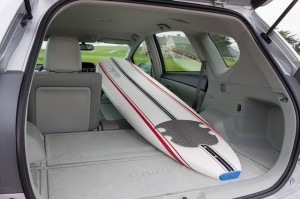
But, the Prius V has its weaknesses, too – including a gas mileage drop relative to the regular Prius (44 city, 40 highway vs. 51 city, 48 highway). It’s also got less real estate for passengers than the C-Max does.
And, it’s really slow. In part because it’s just too damned heavy.
Let’s take a closer look…
WHAT IT IS
The Prius V is a wagon-ized version of the mid-sized Prius hybrid. Its chief draw is greater versatility than the regular hatchback sedan.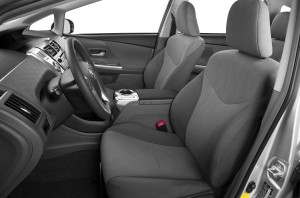
Prices start at $26,650 for the base “Two” trim, which includes automatic climate control AC, a decent stereo rig and 16 inch steel wheels with plastic covers. At the summit is the $30,295 “Five” with 17-inch alloy wheels, SofTex faux leather seat covers, LED headlights – and all the stuff that already comes with the mid-trim “Three”- including navigation/LCD display and Toyota’s Entune electronic interface.
The regular Prius hatchback sedan starts at $24,200.
The Prius V’s main competition is the Ford C-Max, which came out last year. Though smaller overall, it does offer the wagon layout, as well as much better acceleration and comparable fuel efficiency.
Base price for that one is $25,200.
There are virtually no changes for 2013 – because a major update is on deck. The entire Prius line is about to be revamped – and will be sold as 2015s, beginning sometime in early calendar year 2014.
From initial/non-official leakage, the next-Gen Prius will be sexed-up to be more aesthetically and viscerally appealing than the current iterations – and to be more like the peppy/personality-abounding Ford C-Max.
Probably, a plug-in version will be available, too.
WHAT’S GOOD
Extra room for stuff.
More room for stuff than Ford C-Max.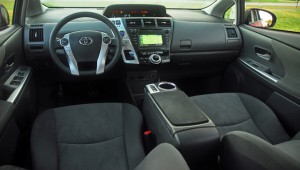
Pretty decent MPGs – for its size/versatility.
Doesn’t have that visually interesting but functionally awkward “floating” center console the standard Prius has.
WHAT’S NOT SO GOOD
Not as much room for people (in both rows) as in the C-Max.
44 city/40 highway is no great shakes anymore … for non-hybrid cars.
Droning/overtaxed engine.
C-Max is two seconds quicker to 60 – and gets the same MPGs . It also costs about $800 less to start.
The Prius V has the same basic drivetrain as the regular Prius – 1.8 liter gas engine teamed up with a pair of electric motors and a battery pack for a combined output of 134 hp.
Two things, however, must be mentioned:
The V is about 230 pounds heavier than the standard Prius (3,274 lbs. vs. 3.042) and it does not have the latest (most efficient) type of battery – lithium ion – which is already being offered in the regular Prius. The V uses nickel metal hydride (NiMH) batteries, which limit how far the car can be driven on electric-power only as well as how fast it can be driven on electric power only.
You can creep along – for about a mile, if the batteries are fully charged – at maybe 20-ish MPH. Any faster – or farther – and the gas engine kicks on.
The additional curb weight – and no-longer-state-of-the-art batteries – explain why the V is slow pokey relative to both the standard Prius as well as the Ford C-Max, which has the perkier lithium ion batteries also.
Zero to 60 in the V takes about 10.5 seconds – vs. about 10 flat for the regular Prius and a much zippier 8.8 seconds for the Ford.
EPA rates the V thusly: 44 city, 40 highway. This is less than the lighter (and lithium-ion assisted) regular Prius, which manages 51 city and 48 highway. However, it’s still just as good as the newer-design Ford’s 45 city, 40 highway.
During my weeklong test-drive I averaged 42.2 MPG.
The least likable quality of the Prius V is not so much that it’s slow – which it is – but that its engine is audibly overworked. It makes a lot of noise – unhappy noise, as my wife describes it. There is an almost-constant background groaning emanating from under the hood, from which you only get a respite when your foot is entirely off the gas pedal (as when coasting down a hill). At almost all other times, the engine is an audible omnipresence – and not in a good way. Some underpowered engines sound all right – or at least, not unpleasant. The overworked 1.8 in the Prius is both noisy and unpleasantly noisy.
I don’t fault the engine, though. The 1.8 liter is Toyota’s small block Chevy – they put it (or a version of it) in numerous other Toyota models – and even in the regular Prius, it does ok.
But in the V, not so much. Because there’s simply too much weight for it to cope with.
The regular Prius would be screaming, too . . . if a couple of 230 pound guys (or one small block Chevy engine) were plopped down on its seats.
The thing to know is this: The V is much closer to marginal (in terms of power/performance) than the standard Prius as a result of its empty curb weight. With two good-sized adults added to the tally, the V’s 134 hp Maximum Effort is facing almost 3,700 pounds. That is an equation whose sum equals flaccid forward motion – accompanied by the sounds of sadness.
The C-Max Ford is vastly more athletic – and its engine sings. That it also manages to achieve the same (slightly better, actually) mileage really puts the hurtin’ on the Prius.
Another curveball is diesel-powered otherwise-similars like the VW Jetta Sportwagen TDI (base price $26,250). Though not quite as fuel efficient as the Prius V – 30 city, 42 highway – it is also (like the C-Max) much quicker on its feet than the V: zero to 60 in about 8.9 seconds.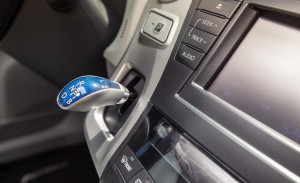
You can also get a much-more-fun-to-play with manual transmission (six speed!) in the Jetta TDI – vs. the Game Boy toggle shifter and CVT automatic in the Toyota.
Where the Prius continues to excel, however, is in bumper-to-bumper driving. In city-type conditions I’ve found it’s possible – realistically doable – to better the EPA rated 44 MPG. Because – in part – you can operate in EV (electric mode) for longer periods of time and also because the gas engine, when it’s on, doesn’t have to work as hard – vs. trying to maintain say 70 MPH on the highway.
This is why you’ll see a goodly number of Prius Vs in service as taxis in big cities.
The flip side of this, of course, is that the V (and the regular Prius) are at a disadvantage on the highway, which for their layout is the worst-possible scenario, as far as maximizing MPGs. If you do a lot of highway driving, a car like the TDI Jetta would probably be a better choice than any current hybrid.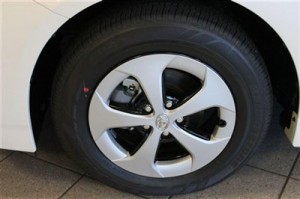
The V’s ride is surprisingly firm – probably a function of all that unsprung mass. It’s ok on smooth roads, but dips in the road – and potholes – will be felt. My test car was a Five with the upgrade 17 inch wheel/tire package – which, frankly, strike me as silly wheels/tires for a hybrid. They cost more, they ride rougher – and they wear out faster. The base Two with the 16 inch wheel/tire package rides smoother – and the tires ought to cost less to replace and should wear less rapidly, too. For sure, the plastic wheel covers will cost you less to replace, if damaged, than the alloy seventeens.
AT THE CURB
There’s no mistaking the dowdy silhouette of the Prius. It defined “hybrid” – with that distinctive Al Gorean, save-the-planet look serving as much as the distinctive hybrid drivetrain to popularize an entirely new way of getting from A to B. It’s the apotheosis of utilitarian – but there is beauty in that, too.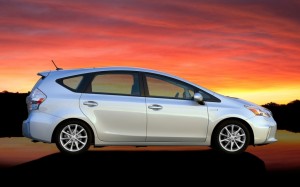
The V wagon all the more so.
Behind the second row, there is 34.3 cubic feet of space for Whatever – vs. 21.6 cubes in the standard Prius.
And 24.5 cubes in the Ford C-Max.
Drop the second row and the V has 67.3 cubes of total space available behind the driver and front row passenger seats – vs. a mere 39.6 cubes, total, in the Prius hatchback sedan.
The C-Max, with its second row down, has just 54.3 cubes of capacity.
True Story: During the week I had the V, I helped a friend of my wife’s move her office stuff to a new office. We got two chairs, a fold-out therapy table, a set of curtain rods and four large bags full of little odds and ends into the Prius with room for more still available. With the regular Prius – or the C-Max – we’d have had to make two trips back and forth instead of just the one.
To be fair to the Ford, I must mention that it has more leg and headroom in both rows than the physically larger overall Prius V. It – the Toyota – is 181.7 inches long vs. 173.6 for the C-Max, a difference of 8.1 inches. Yet it – the Ford – has 43.1 inches of front seat legroom and 36.5 inches in the second row – vs. 41.3 for the V up front and 35.9 inches in the second row. Now you know the reason why the V has so much more cargo space.
However, despite having less total people space than the Ford, I can testify there is still plenty of space for all but the extremely tall. I’m 6ft 3 – which is probably taller than 95 percent of the public- and it fits me with room to spare. If you’re less tall than I am, you definitely will not find the V cramped in either row.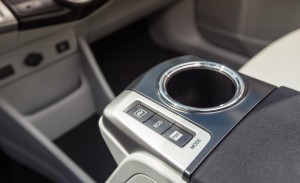
Another difference – already touched on – between the V and the standard Prius is the more normal interior layout. The V does have the same feeling-less toggle shifter – which provides zero tactile feedback – but it does not have the stylistically daring but functionally flawed “floating” center console. Instead, there’s a conventional – and accessible – lower storage cubby, with a conventional in-between-the-seats armrest/storage area. The only slightly unusual design feature is the placement of the hybrid drivetrain’s three driver-selectable modes – ECO, EV and Power – on top of the arm rest – and too near the single cupholder. It is very easy to spill liquids onto these buttons – and they probably don’t appreciate it. Hopefully, the next-gen. Prius will have these controls mounted someplace less vulnerable to a sloshing cup of Starbucks Bold.
There is one other thing about the V – about every current Prius – that is insufferable . But, luckily, it’s probably easy enough to fix – that is, to turn off. I refer here to the relentless and uber-loud DING! DING! DING! DING! that erupts whenever the driver puts the car in reverse. I suppose it’s there because the Prius, being a hybrid, can be very quiet – silent, almost, if it’s operating on just the batteries – and the noise eruption is there to warn pedestrians of the car’s silent maneuvering.
That’s well-intended. But the unintended consequence is that noise is intrusive, annoying – and very distracting. It is hard to think – to focus on the task at hand – when you are being auditorially assaulted in this way.
The buzzer has got to go.
Other stuff: The current V’s age shows in the dated-looking GPS display and also the Entune apps that are available. The ’14s – including the new Corolla I recently reviewed (see here) – have a updated version of Entune, with more apps – and the subscription is free. Inside Skinny: Toyota will include the free subscription – and updated Entune – in all 2014 Toyotas. 
I hope the dual gloveboxes carry over, too.
THE BOTTOM LINE
Should you wait a few months for the 2015s? Unless Toyota nixxes the wagon body style – or really jacks up the price – I’d say there is good reason to. It’s a near-certainty that the next-generation Prius will be more fuel efficient (standard lithium-ion battery pack) and probably perform a bit better, too. Without doubt, it will offer the very latest in gadgetry and software, such as the most recent version of Entune and probably a more graphically appealing (and hopefully, more informative) GPS display.
One should also keep in mind that when they come out early next year, the 2015s are probably going to be very popular, at least until the newness hubub dies down. Until that does happen, it’s a good bet dealers will be able to sell every one they get at full MSRP – and forget about haggling it down. The next guy in line will happily pay whatever you won’t.
Meanwhile, these last few ’13s could be deals – provided dealers are willing to deal. My hunch is they will be, especially as the calendar creeps closer to January 1, 2014.
If you can snap up a current V for less than MSRP, it might be a better choice – slightly dated apps notwithstanding – than a ’15 at full sticker (or more).
Throw it in the Woods?
PS: We have thrown Google – and Google ads – in the woods. They blacklisted us – so we dumped them. See here for the full story about that. So, we need your support to make a go of it and keep EPautos rolling. Please consider supporting this web site in whatever way you’re able. The link to our “donate” area is here.
Thanks in advance!


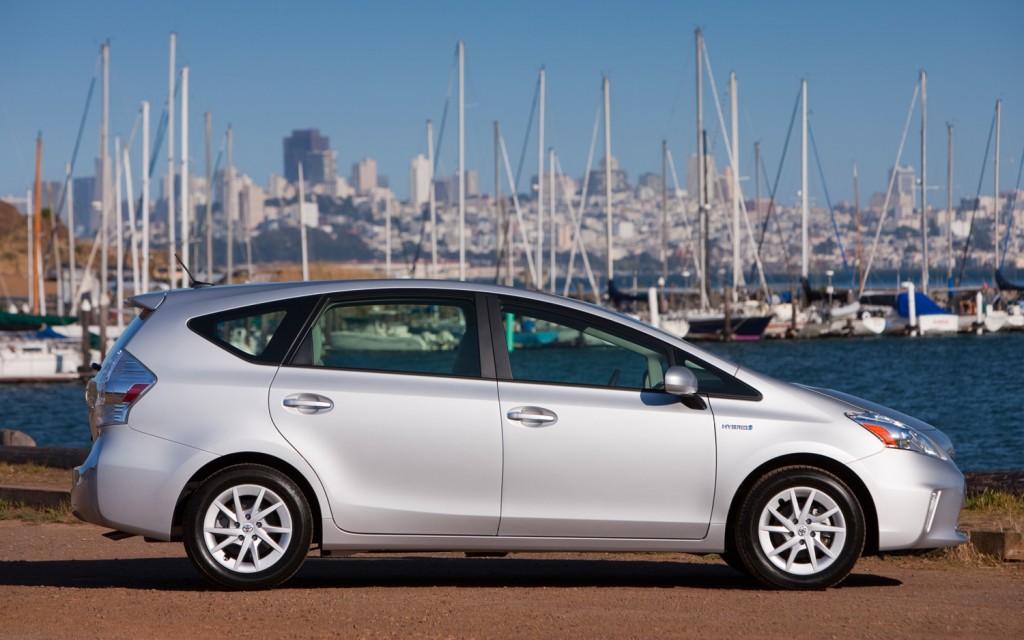



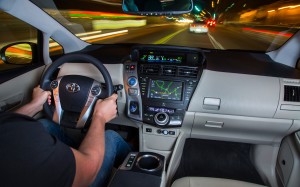

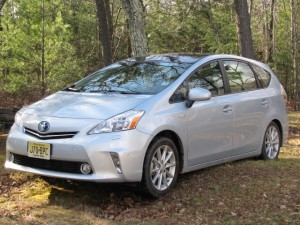







The Prius V looks for all the world like a hatchback. I don’t see nearly enough cargo space (with the 2nd row seats upright) or rear side glass to justify the use of the term “wagon”. Neither, apparently, does Toyota’s web page for the V.
Disclaimer: This post is typed by someone who grew up in 60s and 70s station wagons. In other words, the real thing.
Hi James,
“Wagon” is (for whatever reason) considered a dirty word by the car companies in this market. They rarely use it – unless “sport” is used with it. Obviously, the Prius V cannot be called a “sport wagon.” But a wagon it is.
I, too, recall the station wagons of the ’60s and ’70s. But remember: They were massive (full-size), by the standards of those days) and often seated 7-9, had V-8 engines – and were built on RWD drive-based, full-frame layouts.
The Prius is mid-sized and (obviously) a much smaller vehicle.
I know, Eric. I suppose what I’m wishing for here is a “station wagon standard”, so to speak. Irrespective of vehicle size, it would need to have an established minimum of X cubic feet of cargo space, and Y square inches rear side glass, in order to qualify for the wagon moniker.
It’s interesting to consider why the word wagon is allegedly so unpopular, when our roads are awash in SUVs and CUVs. In my view, these vehicles are nothing more than wagons with a (mild) factory lift. Remove the 4WD/AWD drive trains and install sensibly-sized wheels and tires, and the reality of the “wagon” would be undeniable.
What an odd world we live in.
Morning, James!
“Wagon” is a marketing no-no in this market because of associations with the ’60s and ’70s family haulers. You and I remember them fondly, but – apparently – many others don’t. Hence the automakers’ careful avoidance of the term – and in many cases, their reluctance to even sell the wagon version of a car here that they sell in export markets.
I, too, would love to see the return of a large, 7 passenger wagon without the cost/weight-adding AWD – and with a normal car’s ride height.
Agree, Eric – I remember my first Corolla (79) with a little 1.2L engine and a five speed stick with an overdrive 5th – never got less than 35 MPG, driving rather spritely, at that. But that little, lightweight car is gone due to the regulations passed to “protect us.” As I’ve said many times to anyone who’ll listen, we need to vote in only legislators who will be judged solely in their track record of REMOVING laws from the books!!
That said, just so you know, my everyday drive does indeed include going up and over a mountain pass, not quite as steep as your drive down and back from Floyd, but significant. Even with that, I’ve always managed around 50 mpg in winter, and around 55 in summer. Several years of data points. The Prius, for me, is a superior engineering achievement, which is why I gave my son one and bought another! The battery will probably be available (possibly in upgraded form) from aftermarket suppliers, but many Prius drivers with 100K plus are still on the original battery. I can overlook this car’s few shortcomings (noisy at full throttle, tire noise from less noise insulation than my old Buick) in favor of its many sterling points.
I’ve always maintained that hybrid cars and electric cars are kinda like a “rebound” girlfriend……it’s good for the short-term, but a better thing is needed for the long-term.
http://www.youtube.com/watch?v=Bch5B23_pu0
Here is an interesting video which promises to eliminate the
camshaft from internal combustion engines and great improvement of mileage, power and emissions.
Hi Werner
I know several car companies are looking at electric-pneumatic valve actuation, which in theory is almost infinitely variable (with all the potential advantages that attend).
I’ll miss the mechanical neatness of an eccentric lobe opening and closing the valve, though – just as I often miss the carburetor, despite knowing all about the advantages of EFI!
Hi Eric, I agree! I too often have nostalgia moments! Yet, a couple of decades ago I read that some experts pronounced that further development of the internal combustion engine are useless as it was as far developed as possible! So much for that! Spark plugs will be toast very soon too, replaced by laser ignition. I will have my spark plug socket bronzed and mounted!
Just opt for the standard Prius, either a 2 or 3. The 3 comes with standard rear back-up camera, and a slightly better stereo set-up, which is middlin’ ok. I have 2010 2 and a 2013 3. They are amazing vehicles. Not only do they achieve better than 50 mpg overall, city/hiway, for my driving, but they both also stress typical wear parts like brakes (uses regenerative braking) and fan belts (doesn’t have any!) much less than, say, a Corolla, or a Camry. They also will haul the mail, when required to do so. I’ve put four full-size (read: 6 foot plus) adults in mine for a trip to the beach (375 miles) and still got 50 MPG. There’s just nothing out there that will equal this, especially if your mix of driving includes a lot of around town, under 45 mph, stoplight-to-stoplight sturm und drang. Here, the Prius just excels, delivering easy 50+ MPG ratings, and virtually no wear on brakes. Engine off at stoplights. It’s just a very, very cool car.
Don’t expect to morph it into a pick-up or a mini-van, and you’ll do just fine.
I agree, DR – and good points on the wear items (though of course, one must also take into account potential costs down the road associated with the battery pack and so on).
I’ve driven all forms on the Prius (the C, the standard hatchback sedan, the V, the plug-in, etc.) and find the only significant weakness is they’re not in their element in mountainous areas or when used for extended highway driving (if you’re hoping to get the best mileage out of them). Climbing grades, the drivetrain in the C and V is really noisy. This also drains the battery reserves right quick, which of course doesn’t help optimize mileage.
That said…
If you don’t have to deal with grades/mountainous terrain – or drive the car on the highway for extended periods – you’re absolutely right that obtaining 50-plus MPGs is realistically doable (I’ve done it, too) and there is adequate power for getting around. No Prius model is quick, but this is a relative thing. The best-case scenario (level terrain, near sea level, not loaded up) of 10 or so seconds to 60 is almost twice as quick as something like an old VW Beetle. Now that car was slow! It’s sufficient to go from stop to stoplight, merge – and so on – without being a constant hassle (or imposing hassle on other drivers, as they try to get around you/avoid you).
I’ve long wondered – and expressed in print – how well the Prius would do if it were say 300-400 pounds lighter. My guess is it’d be able to achieve the same adequate/serviceable 0-60 run – and also get 60 MPG – with a smaller (say 1.4 or so liter) gas engine.
It’s too bad the gunvernment won’t allow Toyota or any other automaker to offer a “mileage maximum” version with, say, thinner metal (or plastic composites), no air bags – etc.
The gunvernment says this is “unsafe.”
Perhaps – relative to a car with thicker metal, air bags and so on.
But then, even that car is “unsafe” – relative to say an S-Class Mercedes, which is a much heavier/more structurally reinforced car, with even more in the way of passenger protection features. Should every car be required by law to be as “safe” as an S-Class Mercedes? If not, why? Where – logically – shall the line be drawn?
And why shouldn’t it be the consumer’s option to select the degree of “safety” – vs. efficiency?
If I am willing to accept the potentially higher risk to my person that attends driving a lighter – but much more fuel efficient – car, then isn’t that my business? Just as it is – and ought to be – no one else’s business if another person feels more secure in a heavier, more structurally sound – but less fuel efficient – car.
Unfortunately, the gunvernment won’t allow us these choices.
Jesus you guys get stuck with shit. This is the car people in the US think is so great? I have a 2003 Audi A2 which uses only 0,8 Liters/100Km more than this thing and weighs 80% less.
I don’t understand the 0-60MPH (ca. 100Km/h) thing. More important is acceleration from slow speeds to 100 or 130Km/h. For 0-100, the Audi is rated at 9,8 but in real-world driving, this is not an issue unless the car is fully laden – and even then, not so much. More importantly, it will run 170 with no problems and has NEVER been passed by a Prius which are generally traveling about 120.
Next year, I’ll be trading it for a new (Much-Better-Than-A-Prius)³ Golf Variant 2,0 Diesel which the Prius also outweighs by 240Kg. Its official rating is 0,8 Liters less (generally pretty accurate with VAG products) than what you got and it will run to almost 220Km/h.
We do, Doug… we do!